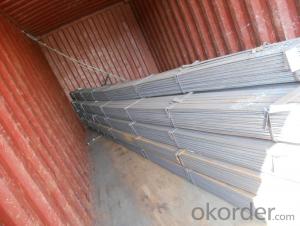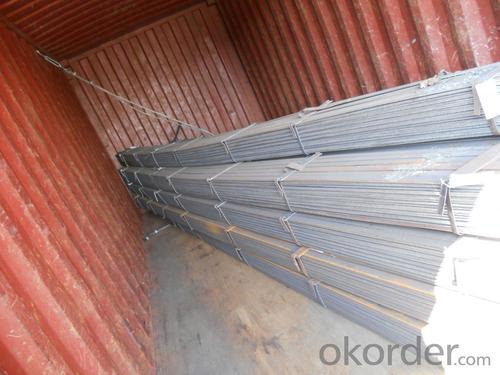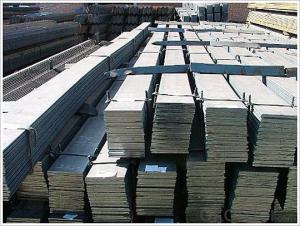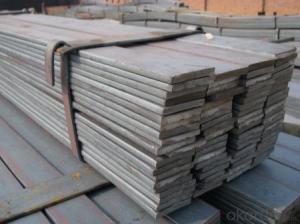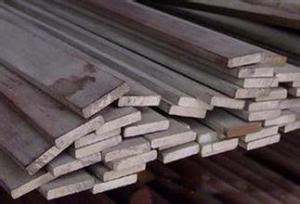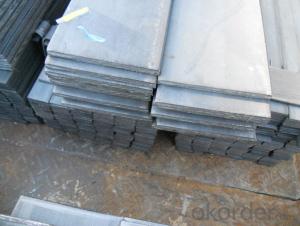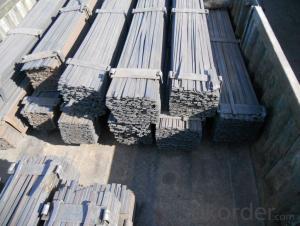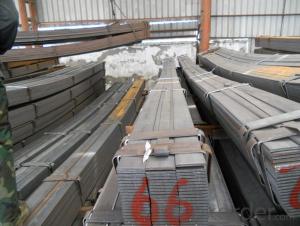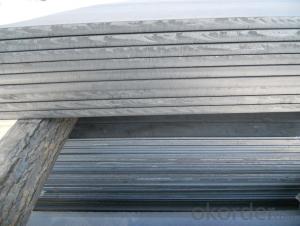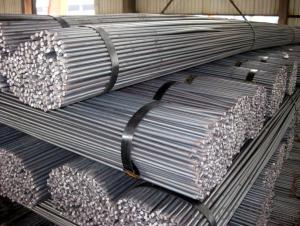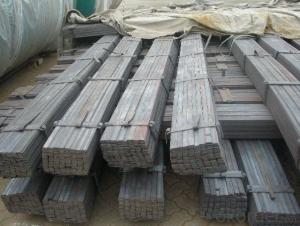Q235, A36, SS400 Hot Rolled Steel Flats Bar
- Loading Port:
- China main port
- Payment Terms:
- TT or LC
- Min Order Qty:
- 25 m.t.
- Supply Capability:
- 200000 m.t./month
OKorder Service Pledge
OKorder Financial Service
You Might Also Like
OKorder is offering Q235, A36, SS400 Hot Rolled Steel Flats Barat great prices with worldwide shipping. Our supplier is a world-class manufacturer of steel, with our products utilized the world over. OKorder annually supplies products to European, North American and Asian markets. We provide quotations within 24 hours of receiving an inquiry and guarantee competitive prices.
Product Applications:
High Qualty Q235, A36, SS400 Hot Rolled Steel Flats Barare ideal for structural applications and are widely used in the construction of buildings and bridges, and the manufacturing, petrochemical, and transportation industries.
Product Advantages:
OKorder's Q235, A36, SS400 Hot Rolled Steel Flats Barare durable, strong, and resist corrosion.
Main Product Features:
· Premium quality
· Prompt delivery & seaworthy packing (30 days after receiving deposit)
· Corrosion resistance
· Can be recycled and reused
· Mill test certification
· Professional Service
· Competitive pricing
Product Description:
Q235, A36, SS400 Hot Rolled Steel Flats Bar
Commodity: Mild Steel Flat Bar
Standard: GB;JIS
Material: Q195-235;SS400
Brand name: FLATSPACE
Origin place: China
Thickness: 3mm-30mm
Width:20mm-200mm
Length: Max 12m
Certification: SGS/BV
Chemical composition of Q235
Alloy No | Grade | Element(%) | ||||
C
| Mn
| S
| P
| Si
| ||
Q235
|
B
|
0.12—0.20 |
0.3—0.7 |
≤0.045 |
≤0.045
|
≤0.3
|
Physical properties of Q235
Alloy No | Grade | Yielding strength point(Mpa) | Tensile strength (Mpa) | Elongation after fracture(%) | ||||||
Thickness (mm) | Thickness (mm) | |||||||||
≤16 | >16--40 | >40--60 | >60--100 | ≤16 | >16--40 | >40--60 | >60--100 | |||
≥ | ≥ | |||||||||
Q235 |
B |
235 |
225 |
215 |
205 |
375--500 |
26 |
25 |
24 |
23 |
Usage/Applications of Q235, A36, SS400 Hot Rolled Steel Flats Bar
Widely used for construction, Machinery manufacturing, Iron tower steel structure, Shipbuilding; Steel grating, Staircase, Bridge, Viaduct, Railway spare parts, Boilers making etc.
Packaging & Delivery of Q235, A36, SS400 Hot Rolled Steel Flats Bar
Packaging Details: The Mild Steel Flat Bars are packed in bundles and loaded in 20 feet/40 feet container, or shipped by bulk cargo ,also we can do as customer's requirements.
Delivery Details:30~45 days upon the receipt of buyer payment by T.T. or L/C.
Production Flow of Q235, A36, SS400 Hot Rolled Steel Flats Bar
The Mild steel flat bar is made through three processes:
1.Feeding the material: Feeding the row material (the steel plate) to Slitting Line.
2.Slitting:The steel plate would be slitted into expected width by lengthways cutter.
3. Leveled and cutting: The plat bar would be ground into level by the grinder and then cut into required length.
FAQ:
Q1: Why buy Materials & Equipment from OKorder.com?
A1: All products offered byOKorder.com are carefully selected from China's most reliable manufacturing enterprises. Through its ISO certifications, OKorder.com adheres to the highest standards and a commitment to supply chain safety and customer satisfaction.
Q2: How do we guarantee the quality of our products?
A2: We have established an advanced quality management system which conducts strict quality tests at every step, from raw materials to the final product. At the same time, we provide extensive follow-up service assurances as required.
Q3: How soon can we receive the product after purchase?
A3: Within three days of placing an order, we will begin production. The specific shipping date is dependent upon international and government factors, but is typically 7 to 10 workdays.
Images:
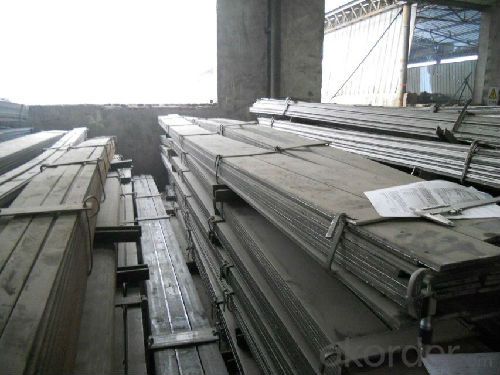
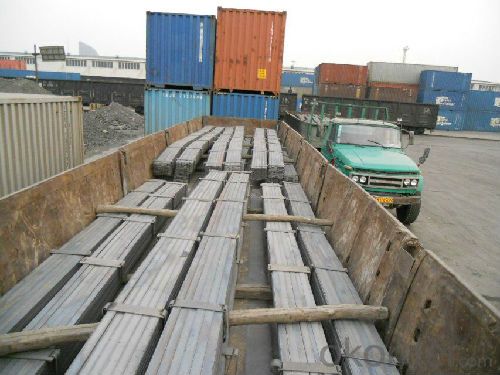
- Q: How do you store steel flat bars?
- Steel flat bars can be stored in a variety of ways depending on the available space and the quantity of bars to be stored. Here are a few common methods: 1. Vertical storage: This is a space-saving method where steel flat bars are stored vertically in a rack or a specially designed storage system. The bars are stacked one on top of another and secured in place to prevent any movement or falling. 2. Horizontal storage: In this method, steel flat bars are stored horizontally on a flat surface such as a shelf or pallet. They can be organized by size or length to ensure easy access and efficient use of space. It is important to properly stack and secure the bars to prevent any damage or accidents. 3. Wall-mounted storage: If floor space is limited, wall-mounted storage racks can be used. These racks have hooks or brackets where the steel flat bars can be hung vertically. This method not only saves space but also allows for easy identification and access to the bars. 4. Storage cabinets or drawers: For smaller quantities of steel flat bars, storage cabinets or drawers can be used. These provide a secure and organized storage solution, protecting the bars from dust, moisture, and other potential damages. Regardless of the chosen storage method, it is important to keep steel flat bars in a clean, dry, and well-ventilated area to prevent rust or corrosion. Additionally, it is advisable to label the bars with their dimensions or specifications for easy identification and inventory management.
- Q: Can steel flat bars be bent without cracking?
- Yes, steel flat bars can be bent without cracking, as long as the bending process is carried out within the material's specified limits and proper techniques are used.
- Q: How do you determine the fatigue strength of a steel flat bar?
- To determine the fatigue strength of a steel flat bar, there are several steps and tests that can be conducted. Firstly, it is important to understand what fatigue strength refers to. Fatigue strength is the maximum stress level at which a material can endure cyclic loading without experiencing failure or damage. In the case of a steel flat bar, it is crucial to determine its fatigue strength to ensure its durability and reliability in applications where it will be subjected to repeated or cyclic loading. One common method to determine the fatigue strength is by conducting a fatigue test. This test involves subjecting the steel flat bar to cyclic loading, usually in the form of alternating tensile and compressive stresses. The test is typically performed using a machine called a fatigue testing machine or a universal testing machine equipped with a fatigue testing rig. During the fatigue test, the steel flat bar is loaded with a specific stress level that is known as the stress amplitude. The stress amplitude represents the difference between the maximum and minimum stress levels experienced by the material during each loading cycle. The test is usually conducted at a constant stress amplitude, and the number of cycles to failure is recorded. By plotting the stress amplitude against the number of cycles to failure on a graph, a fatigue curve or S-N curve can be obtained. This curve provides valuable information about the fatigue strength of the steel flat bar. It shows the relationship between the stress amplitude and the number of cycles to failure, allowing engineers and researchers to determine the fatigue limit or endurance limit of the material. The fatigue limit is the maximum stress amplitude that the steel flat bar can withstand without experiencing failure after an infinite number of cycles. It represents the threshold below which the material will not fail due to fatigue, making it an essential parameter to consider in design and engineering applications. In addition to fatigue testing, other factors that contribute to the fatigue strength of a steel flat bar include its surface finish, material composition, heat treatment, and residual stresses. These factors can be analyzed and adjusted to enhance the fatigue strength of the material if necessary. Overall, determining the fatigue strength of a steel flat bar involves conducting fatigue tests, analyzing fatigue curves, and considering various factors that affect the material's endurance limit. This information is crucial for ensuring the safe and reliable performance of the steel flat bar in applications subjected to cyclic loading.
- Q: Can steel flat bars be used for making brackets or supports for agricultural machinery?
- Yes, steel flat bars can be used for making brackets or supports for agricultural machinery. Steel is a durable and strong material, making it suitable for providing the necessary support and stability required in agricultural machinery. Additionally, steel is resistant to corrosion, which is crucial in agricultural environments that are often exposed to moisture and harsh weather conditions.
- Q: Are steel flat bars resistant to wear or abrasion?
- Yes, steel flat bars are highly resistant to wear and abrasion. The hardness and durability of steel make it an excellent choice for applications where resistance to friction and abrasion is crucial. Steel flat bars can withstand heavy loads and repeated impact, making them ideal for various industries such as construction, manufacturing, and machinery.
- Q: What are the different tolerances for steel flat bars?
- The tolerances for steel flat bars can vary depending on the specific requirements and industry standards. Generally, the most common tolerances for steel flat bars are determined by the American Society for Testing and Materials (ASTM) or the International Organization for Standardization (ISO). The tolerances for steel flat bars typically include dimensions such as width, thickness, and length. These dimensions are specified to ensure that the flat bars meet certain quality standards and can be used effectively in various applications. For width tolerances, the range can vary from as tight as ±0.005 inches (0.13 mm) to as loose as ±0.25 inches (6.35 mm). The specific tolerance is typically determined based on the required precision and application of the steel flat bar. For thickness tolerances, the range can vary from ±0.005 inches (0.13 mm) to ±0.25 inches (6.35 mm). Again, the specific tolerance depends on the desired precision and application. Length tolerances for steel flat bars can range from ±0.125 inches (3.18 mm) to ±1 inch (25.4 mm). This tolerance is crucial to ensure that the flat bars can be accurately cut to the desired length and fit properly in the intended application. It is important to note that these tolerances are just general guidelines and can vary based on the specific standards set by the manufacturer or customer requirements. It is always recommended to consult the relevant industry standards or specifications to determine the specific tolerances for steel flat bars in a particular application.
- Q: How are steel flat bars used in construction?
- Steel flat bars are commonly used in construction for a variety of purposes. One of the main uses of steel flat bars is as structural support in buildings and infrastructure. They are often used as beams or columns to provide stability and strength to structures. Steel flat bars are also used for framing and bracing in construction projects. They can be used to create frames for walls, roofs, and floors, providing a sturdy framework for the rest of the building components. In addition, steel flat bars are utilized for reinforcing concrete structures. They are commonly embedded within concrete slabs or walls to enhance their strength and prevent cracking or structural failure. The bars act as tension members, distributing the forces evenly and improving the overall durability of the concrete structure. Moreover, steel flat bars are employed for manufacturing various construction components, such as brackets, connectors, and supports. These components are crucial for joining different elements of a building together, ensuring their stability and functionality. Overall, steel flat bars play a vital role in construction by providing structural support, reinforcing concrete, and manufacturing essential components. Their versatility, strength, and durability make them a preferred choice for many construction projects.
- Q: Are steel flat bars suitable for load-bearing shelves or platforms?
- Yes, steel flat bars are suitable for load-bearing shelves or platforms. Steel is known for its strength and durability, making it a reliable choice for supporting heavy loads. The flat shape of the bars provides stability and even weight distribution, making them ideal for load-bearing applications.
- Q: Can steel flat bars be used in architectural applications?
- Yes, steel flat bars can indeed be used in architectural applications. Steel flat bars are versatile and durable, making them suitable for various architectural uses. They can be utilized in the construction of structural elements such as beams, columns, and braces, providing stability and strength to buildings. Additionally, steel flat bars can be used for decorative purposes, such as handrails, balustrades, and cladding, adding a modern and sleek aesthetic to architectural designs. With their high tensile strength and resistance to corrosion, steel flat bars are a reliable choice for architects seeking both functionality and aesthetics in their projects.
- Q: Can steel flat bars be heat-treated?
- Indeed, it is possible to subject steel flat bars to heat treatment. By undergoing controlled heating and cooling, this process effectively transforms the physical and at times chemical attributes of the steel. The objective behind heat treatment varies, encompassing the augmentation of hardness, the enhancement of strength, the fortification of toughness, and the customization of other mechanical properties to meet specific application requirements. Depending on the desired results, various heat treatment techniques such as annealing, normalizing, quenching, and tempering may be employed on steel flat bars.
Send your message to us
Q235, A36, SS400 Hot Rolled Steel Flats Bar
- Loading Port:
- China main port
- Payment Terms:
- TT or LC
- Min Order Qty:
- 25 m.t.
- Supply Capability:
- 200000 m.t./month
OKorder Service Pledge
OKorder Financial Service
Similar products
Hot products
Hot Searches
Related keywords
